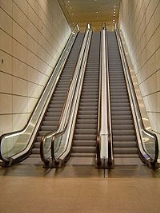
Passengers per hour per direction
Encyclopedia
Passengers per hour per direction or passengers per hour in peak direction (PPHPD or p/h/d) is a transport
-related term used to describe the capacity of a rapid transit
or public transport
system.
 Many public transport system handle a highly directional flow of passengers—often traveling to work to a city
Many public transport system handle a highly directional flow of passengers—often traveling to work to a city
in the morning rush hour
and away from a city in the late afternoon. To increase the passenger throughput, many systems can be reconfigured to change the direction of the optimised flow. A common example is a railway
or metro station
with more than two parallel escalator
s, where the majority of the escalators can be set to move in one direction. This gives rise to the measure of the peak-flow rather than a simple average of half of the total capacity.
Transport
Transport or transportation is the movement of people, cattle, animals and goods from one location to another. Modes of transport include air, rail, road, water, cable, pipeline, and space. The field can be divided into infrastructure, vehicles, and operations...
-related term used to describe the capacity of a rapid transit
Rapid transit
A rapid transit, underground, subway, elevated railway, metro or metropolitan railway system is an electric passenger railway in an urban area with a high capacity and frequency, and grade separation from other traffic. Rapid transit systems are typically located either in underground tunnels or on...
or public transport
Public transport
Public transport is a shared passenger transportation service which is available for use by the general public, as distinct from modes such as taxicab, car pooling or hired buses which are not shared by strangers without private arrangement.Public transport modes include buses, trolleybuses, trams...
system.
Directional flow

City
A city is a relatively large and permanent settlement. Although there is no agreement on how a city is distinguished from a town within general English language meanings, many cities have a particular administrative, legal, or historical status based on local law.For example, in the U.S...
in the morning rush hour
Rush hour
A rush hour or peak hour is a part of the day during which traffic congestion on roads and crowding on public transport is at its highest. Normally, this happens twice a day—once in the morning and once in the evening, the times during when the most people commute...
and away from a city in the late afternoon. To increase the passenger throughput, many systems can be reconfigured to change the direction of the optimised flow. A common example is a railway
Train station
A train station, also called a railroad station or railway station and often shortened to just station,"Station" is commonly understood to mean "train station" unless otherwise qualified. This is evident from dictionary entries e.g...
or metro station
Metro station
A metro station or subway station is a railway station for a rapid transit system, often known by names such as "metro", "underground" and "subway". It is often underground or elevated. At crossings of metro lines, they are multi-level....
with more than two parallel escalator
Escalator
An escalator is a moving staircase – a conveyor transport device for carrying people between floors of a building. The device consists of a motor-driven chain of individual, linked steps that move up or down on tracks, allowing the step treads to remain horizontal.Escalators are used around the...
s, where the majority of the escalators can be set to move in one direction. This gives rise to the measure of the peak-flow rather than a simple average of half of the total capacity.

